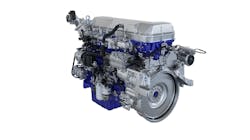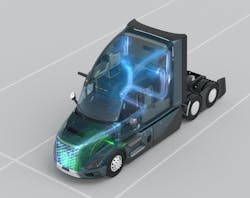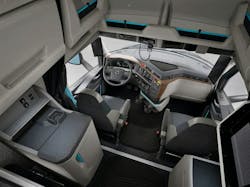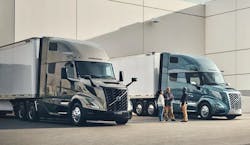After six years of development, fleets will soon be able to get their hands on the re-engineered Volvo VNL tractor, developed by the U.S. team of Volvo Trucks North America. OEM leaders said it will be the base platform for current and future transportation technologies—from diesel to renewable fuels. It will be available in six cab configurations.
The truck was designed for fuel efficiency, safety, driver productivity, connectivity, and uptime. VTNA leaders said it would open order books by April for the new Class 8 truck, which will be produced at the Volvo Trucks New River Valley Plant in Dublin, Virginia, with first deliveries during the second half of 2024.
"This is our most innovative, fuel-efficient, and safest truck ever," Peter Voorhoeve, VTNA president, said during the OEM's virtual unveiling of the vehicle during a YouTube live stream on Jan. 23. "From our aerodynamics and performance improvements, best-in-class driver environment to our new industry-leading proprietary active safety systems, with the new Volvo VNL we are introducing the platform for all our future technologies such as battery electric fuel cell and autonomous trucks. Products that address and meet our sustainability goals to transition towards a decarbonized transport solution."
The new Volvo VNL, designed for long-haul trucking, will be packaged into four exterior and interior trim levels—Core, Edge, Edge Black, and Ultimate—with six cab configurations, including a day cab option:
- VNL 300 Day Cab
- VNL 440 42-inch Mid-Roof Sleeper
- VNL 640 62-inch Mid-Roof Sleeper
- VNL 660 62-inch Full-Height Sleeper
- VNL 840 74-inch Mid-Roof Sleeper
- VNL 860 74-inch Full-Height Sleeper
Powertrain and efficiency
The latest generation D13 engine powers the new Volvo VNL in four horsepower ratings, ranging from 405 to 500 hp, and three torque ratings from 1,750 to 1,950 ft.-lb. of torque. These different power options aim to suit different applications and incorporate an optimized I-Shift transmission featuring up to 30% faster shift speeds.
Voorhoeve said the new VNL platform was designed "to be compliant with all the regulations now and in the future." The next big emissions regulations hit in 2027 with when U.S. Environmental Protection Agency's new rules take effect.
Read more: The Amazing Emissions Race
A new linear exhaust aftertreatment system was added to make it easier to service and deliver better DEF treatment into the aftertreatment system.
The 24-volt architecture will help improve uptime and serviceability by helping to minimize battery and electrical failures and also making it easier to pinpoint and repair electrical issues, the company explained.
Several changes were made to streamline the cab design to improve the aerodynamics, resulting in what Volvo says is 10% better fuel-efficiency over previous models. These include:
- More angular, wedge-shape cab
- Redesigned cured and bonded windshield
- Tighter clearances around wheel openings, bumper and hood, chassis fairings, and trailer gap
Testing was done in parallel with Volvo Trucks' SuperTruck 2, according to Johan Agebrand, Volvo Trucks' product marketing director.
The stricter emissions regulations facing the industry later this decade are on VNL engineers' minds, but Agebrand said they were the "minimum bar of what needs to be in there. That's not good enough for us at Volvo. We go far beyond that. So the majority of stuff in there is about what kind of truck we want to provide for the next seven, 10 years. Is it regulations? Yeah, we need to comply. But that has not been the benchmark to go by—we far surpass that."
Even when parked, the sleek new VNL was designed for efficiency. The new ultra-quiet, proprietary, integrated Volvo Parking Cooler, which Volvo called its "most efficient idle management tool," utilizes the onboard 24-volt battery system to power the cab’s HVAC when parked. This reduces emissions, engine wear, and fuel costs, as well as idling noise and vibration.
Connectivity
Not only does VTNA tout the new VNL as their safest and most fuel-efficient truck, but it's also their "most connected truck ever," said Nicole Portello, VTNA's chief digital officer. She noted how the truck builds on the extensive Volvo Connect telematics platform launched last fall to put all of Volvo Trucks' digital services into one platform for better fleet management. All new Volvo trucks come with a 24-month Volvo Connect subscription.
Drivers can also stay connected to their VNL with the Volvo MyTruck app, which lets drivers monitor fuel, DEF, and coolant levels and receive notifications about potential problems. They can also remotely set the cab's climate control to reach their preferred temperature before they hop in for work.
Safety and driver features
The new VNL offers various active safety systems, including Volvo Active Driver Assist Plus with Pilot Assist, which provides active lane centering. Volvo Dynamic Steering powers Volvo Active Driver Assist Plus to improve maneuvering at all speeds, including more controlled backing and increased stability on the road. It adapts and corrects for crosswinds, highway crowning, soft shoulders, or emergencies such as tire failure.
Additional safety offerings include:
- Side-curtain airbag, with options for driver-only or driver and passenger airbags
- Flared frame rails that allow the powertrain to drop below the cab to protect driver
- E-Call that automatically connects driver to emergency services and provides precise location details when airbags are deployed
- Pedestrian detection feature that activates emergency braking for objects directly in path of travel
Volvo offers a new, optional air suspension system, GRAS (Global Rear Air Suspension), that uses dual leveling rods to reduce roll and pitch angles, improve lateral stability, and minimize road shocks, maintaining a constant ride height.
GRAS and the supporting Volvo Smart Suspension software work with the Volvo Dynamic Steering system to provide precise steering control and reduce driver fatigue regardless of load, terrain, road conditions, and varying engine torque levels. GRAS with Volvo Smart Suspension gives drivers three different settings to adjust the suspension for various loading and unloading conditions.
In-cab amenities include an optional folding bunk to allow access to the dinette space, a singular multi-functional control panel in the back of the cab, upgraded climate control and noise reduction insulation, a larger refrigerator, and enough power options to support various devices.








